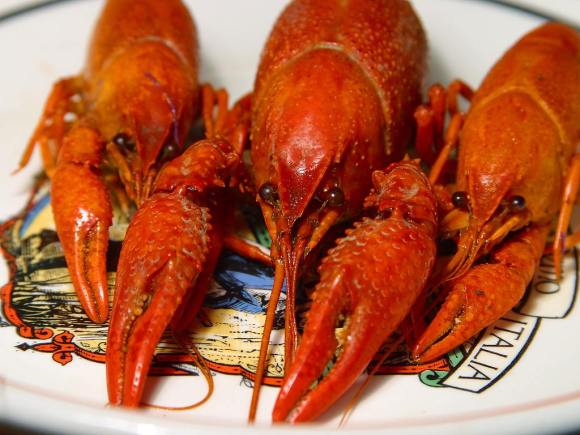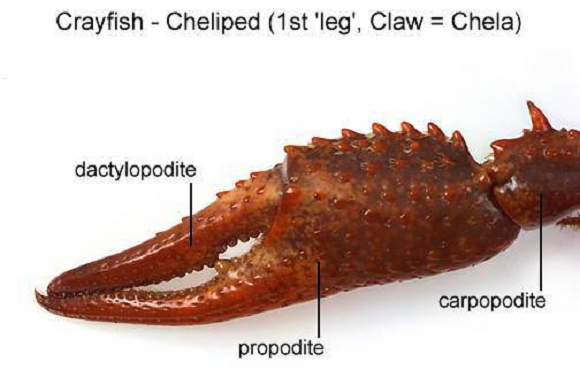
On 17 April, a man whom the Chinese media is referring to as Zhang headed for the toilet to perform a crucial part of his morning routine. There would be no chance to catch up on the sports section of his paper this day, however.
During his bowel movement the man in his 40s experienced a severe pain in his anus. It wasn’t until the pain grew so intense that he could barely walk that Zhang decided to seek medical help.
And so begins a lesson on chewing your food properly.
Zhang was rushed to Zhengzhou People’s Hospital in Zhengzhou City, Henan. Staff in the proctology department began probing and found a foreign object obstructing the end of his digestive tract. Unable to identify it, the doctors braced themselves for an awkward conversation with Zhang about what it could be.
The patient wasn’t sure, but one possibility he could recall happened about a week earlier. He was out with some friends drinking and eating some spicy fried crayfish. Due to his drunken state Zhang admitted there was a chance he may have swallowed a piece of shell or claw.
Let’s take a moment to look at a crayfish claw and try to image what it would be like to have that pass through your system.
Doctors weren’t sure if Zhang’s suspicions were right at that time but knew that if they attempted to pull out the object, it could cause a tear resulting in major bleeding. In the end they decided to hospitalize him and prepare for surgery.
The procedure went off without a hitch and the staff were able to successfully remove a two-centimeter by two-centimeter (0.8-inch by 0.8-inch) crayfish claw from Zhang’s anus. Zhang was discharged two days later and is also expected to discharge himself normally again in the future.
To find out for sure, RocketNews24 consulted an expert on the matter: “Doctor” Hiroyuki “Buttman” Tanaka who hangs out by the 7-Eleven. We asked the “doctor” if it was possible any further damage could have been done to Zhang’s rectum to which he replied “Rectum?! It damn near killed him!”
Source: Livedoor News via Hachima Kiko (Japanese)
Top Image: Wikipedia – Hephaestos
Inset Image: Biology Junction


 Japanese beef bowl chain Sukiya’s 2026 Smile Box lucky bag basically pays for itself
Japanese beef bowl chain Sukiya’s 2026 Smile Box lucky bag basically pays for itself Rakuten randomly offers 58 New Year’s osechi feasts in Japan, but did we get a star or a dud?
Rakuten randomly offers 58 New Year’s osechi feasts in Japan, but did we get a star or a dud? Majority of Japanese mayors say foreign residents are essential but most see good and bad effects
Majority of Japanese mayors say foreign residents are essential but most see good and bad effects Village Vanguard’s most expensive Black Lucky Bag sets an ominous tone for 2026
Village Vanguard’s most expensive Black Lucky Bag sets an ominous tone for 2026 Cardcaptor Sakura Chinese Cafe opens in Tokyo, coming to other cities with special merch【Pics】
Cardcaptor Sakura Chinese Cafe opens in Tokyo, coming to other cities with special merch【Pics】 Japanese beef bowl chain Sukiya’s 2026 Smile Box lucky bag basically pays for itself
Japanese beef bowl chain Sukiya’s 2026 Smile Box lucky bag basically pays for itself Rakuten randomly offers 58 New Year’s osechi feasts in Japan, but did we get a star or a dud?
Rakuten randomly offers 58 New Year’s osechi feasts in Japan, but did we get a star or a dud? Majority of Japanese mayors say foreign residents are essential but most see good and bad effects
Majority of Japanese mayors say foreign residents are essential but most see good and bad effects Village Vanguard’s most expensive Black Lucky Bag sets an ominous tone for 2026
Village Vanguard’s most expensive Black Lucky Bag sets an ominous tone for 2026 Cardcaptor Sakura Chinese Cafe opens in Tokyo, coming to other cities with special merch【Pics】
Cardcaptor Sakura Chinese Cafe opens in Tokyo, coming to other cities with special merch【Pics】 Shinkansen: “Seats can be quickly used as shields in the event of an attack”
Shinkansen: “Seats can be quickly used as shields in the event of an attack” We suspected this Japanese cable car was an overpriced tourist trip, but we underestimated it
We suspected this Japanese cable car was an overpriced tourist trip, but we underestimated it Japan’s otoshidama tradition of giving kids money at New Year’s gets a social welfare upgrade
Japan’s otoshidama tradition of giving kids money at New Year’s gets a social welfare upgrade Pizza Hut Japan’s hot lucky bags are perfect for a New Year’s pizza party
Pizza Hut Japan’s hot lucky bags are perfect for a New Year’s pizza party Stamina-destroying “Paralysis Noodles” are Tokyo’s newest over-the-top ramen innovation
Stamina-destroying “Paralysis Noodles” are Tokyo’s newest over-the-top ramen innovation Starbucks Japan ready to get Year of the Horse started with adorable drinkware and plushies【Pics】
Starbucks Japan ready to get Year of the Horse started with adorable drinkware and plushies【Pics】 Hayao Miyazaki says Happy New Year to Studio Ghibli fans with new art for Year of the Horse
Hayao Miyazaki says Happy New Year to Studio Ghibli fans with new art for Year of the Horse We found possibly the quietest Japanese-style hotel in Tokyo’s bustling Shinjuku district
We found possibly the quietest Japanese-style hotel in Tokyo’s bustling Shinjuku district Cup Noodle tries an authentic Jiro-style ramen, but something’s not quite right
Cup Noodle tries an authentic Jiro-style ramen, but something’s not quite right The best Starbucks Japan Frappuccinos we want to drink again in 2026
The best Starbucks Japan Frappuccinos we want to drink again in 2026 We revisited Sweets Paradise after a decade to see if Japan’s dessert buffet still delivers
We revisited Sweets Paradise after a decade to see if Japan’s dessert buffet still delivers That time Seiji called JASRAC to ask why he didn’t get paid royalties for his song being on TV
That time Seiji called JASRAC to ask why he didn’t get paid royalties for his song being on TV Japan’s oldest largetooth sawfish in captivity back on display in Mie Prefecture
Japan’s oldest largetooth sawfish in captivity back on display in Mie Prefecture 7-Eleven Japan starts new temporary luggage storage service in over 300 branches
7-Eleven Japan starts new temporary luggage storage service in over 300 branches Disillusionment at Tsukiji’s tourist-target prices led us to a great ramen restaurant in Tokyo
Disillusionment at Tsukiji’s tourist-target prices led us to a great ramen restaurant in Tokyo Starbucks teams up with 166-year-old Kyoto doll maker for Year of the Horse decorations【Photos】
Starbucks teams up with 166-year-old Kyoto doll maker for Year of the Horse decorations【Photos】 Tokyo considering law requiring more trash cans following litter increase in heavily touristed area
Tokyo considering law requiring more trash cans following litter increase in heavily touristed area Tokyo’s Tsukiji sushi neighborhood asks tour groups to stay away for the rest of the month
Tokyo’s Tsukiji sushi neighborhood asks tour groups to stay away for the rest of the month Tokyo event lets you travel back in time, for free, to celebrate 100 years since Showa era start
Tokyo event lets you travel back in time, for free, to celebrate 100 years since Showa era start Japan may add Japanese language proficiency, lifestyle classes to permanent foreign resident requirements
Japan may add Japanese language proficiency, lifestyle classes to permanent foreign resident requirements Sanrio theme park in Japan announces plans to expand into a Sanrio resort
Sanrio theme park in Japan announces plans to expand into a Sanrio resort Survey asks foreign tourists what bothered them in Japan, more than half gave same answer
Survey asks foreign tourists what bothered them in Japan, more than half gave same answer Japan’s human washing machines will go on sale to general public, demos to be held in Tokyo
Japan’s human washing machines will go on sale to general public, demos to be held in Tokyo Japan’s deadliest food claims more victims, but why do people keep eating it for New Year’s?
Japan’s deadliest food claims more victims, but why do people keep eating it for New Year’s? We deeply regret going into this tunnel on our walk in the mountains of Japan
We deeply regret going into this tunnel on our walk in the mountains of Japan Studio Ghibli releases Kodama forest spirits from Princess Mononoke to light up your home
Studio Ghibli releases Kodama forest spirits from Princess Mononoke to light up your home Major Japanese hotel chain says reservations via overseas booking sites may not be valid
Major Japanese hotel chain says reservations via overseas booking sites may not be valid Put sesame oil in your coffee? Japanese maker says it’s the best way to start your day【Taste test】
Put sesame oil in your coffee? Japanese maker says it’s the best way to start your day【Taste test】 No more using real katana for tourism activities, Japan’s National Police Agency says
No more using real katana for tourism activities, Japan’s National Police Agency says Starbucks Japan reveals new sakura drinkware collection, inspired by evening cherry blossoms
Starbucks Japan reveals new sakura drinkware collection, inspired by evening cherry blossoms Updated cherry blossom forecast shows extra-long sakura season for Japan this year
Updated cherry blossom forecast shows extra-long sakura season for Japan this year Shinkansen: “Seats can be quickly used as shields in the event of an attack”
Shinkansen: “Seats can be quickly used as shields in the event of an attack” We suspected this Japanese cable car was an overpriced tourist trip, but we underestimated it
We suspected this Japanese cable car was an overpriced tourist trip, but we underestimated it Japan’s otoshidama tradition of giving kids money at New Year’s gets a social welfare upgrade
Japan’s otoshidama tradition of giving kids money at New Year’s gets a social welfare upgrade Pizza Hut Japan’s hot lucky bags are perfect for a New Year’s pizza party
Pizza Hut Japan’s hot lucky bags are perfect for a New Year’s pizza party Stamina-destroying “Paralysis Noodles” are Tokyo’s newest over-the-top ramen innovation
Stamina-destroying “Paralysis Noodles” are Tokyo’s newest over-the-top ramen innovation Four Shinto shrines to pray for love at in Japan to start the New Year
Four Shinto shrines to pray for love at in Japan to start the New Year Six new Sailor Moon cafes to be open simultaneously in Japan this fall!【Photos】
Six new Sailor Moon cafes to be open simultaneously in Japan this fall!【Photos】 Anime holy ground – A visit to the real-world location of Look Back【Photos】
Anime holy ground – A visit to the real-world location of Look Back【Photos】 Majority of surveyed Japanese workers have dated a coworker, over 20 percent their boss or senpai
Majority of surveyed Japanese workers have dated a coworker, over 20 percent their boss or senpai You can now visit a recreation of Evangelion’s Tokyo-3 and live there in miniature form in【Pics】
You can now visit a recreation of Evangelion’s Tokyo-3 and live there in miniature form in【Pics】 Tokyo fish market breaks New Year auction record as single fish sells for over 5 million yen【Vid】
Tokyo fish market breaks New Year auction record as single fish sells for over 5 million yen【Vid】 What’s in a Lawson fukubukuro lucky bag?
What’s in a Lawson fukubukuro lucky bag? This frozen “lucky bag” from a leading sushi chain has absolutely no sushi in it
This frozen “lucky bag” from a leading sushi chain has absolutely no sushi in it Free to download Japanese marriage applications are cute, stylish, and legally binding
Free to download Japanese marriage applications are cute, stylish, and legally binding
Leave a Reply